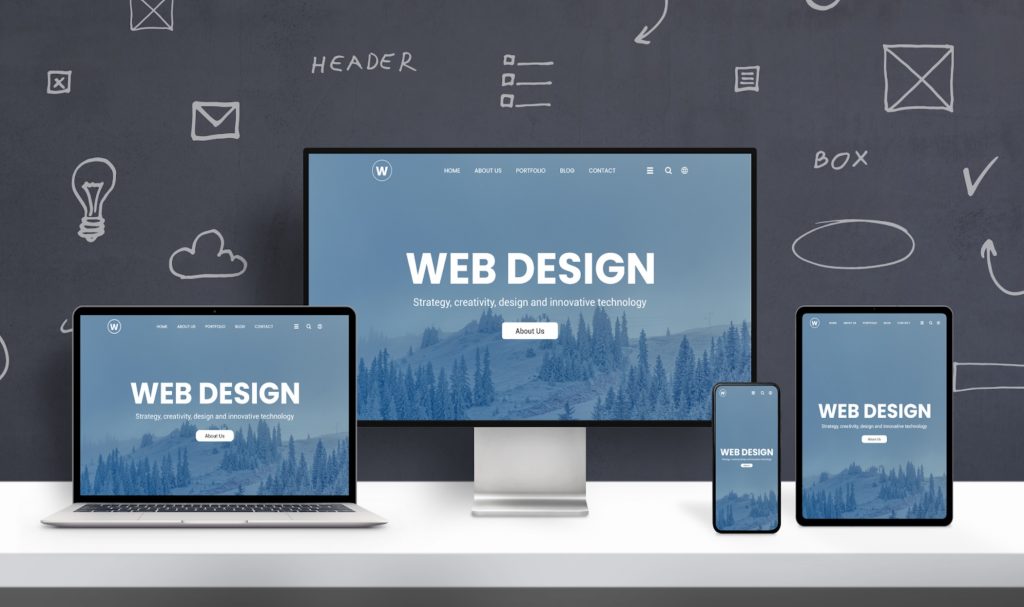Amplifying User Experience Through Intuitive Website Design

Image via Dreamstime Illustrations & Vectors
Introduction
In the constantly evolving realm of technology, standing out among the endless sea of websites is crucial and often a challenging endeavor. This is where user experience (UX) and website design come into play.
Importance of User Experience and Website Design in the Digital Age
UX focuses on delivering a positive and engaging experience for users navigating through online platforms. With this, the intuitive website design meshes seamlessly. Incorporating intuitive website design means creating a site that’s easy to comprehend and use, even for first-time visitors, ultimately leading to higher engagement and conversions.
• Easy Navigation: Websites that are easier to navigate attract and retain more users.
• Engagement: A site that offers an intuitive and exciting user interface increases user-engagement levels.
• Conversions: Intuitive design aids efficient navigation and decision-making processes, driving higher conversion rates.
Synopsis of the Blog
In this post, we explore ways to amplify user experience through intuitive website design. We’ll look into how understanding and adopting a strategy centered on these paradigms can result in a more optimized website, heightening user engagement and satisfaction. Stay tuned as we unearth the secrets to a more user-friendly site.
Understanding User Experience
To delve into the world of web development and design, it’s crucial to first understand the concept of User Experience.
Definition and Overview
“User Experience” or “UX” is an umbrella term that encapsulates how a user interacts with, feels about, and utilizes a product, system, or service. In the context of web development, UX refers to the overall experience a visitor has while navigating a website. This encompasses everything from site navigation, ease of use, to the emotional response elicited by the website’s aesthetics.
Importance of User Experience in Web Development
Laying emphasis on User Experience in web development isn’t just a trend—it’s a necessity. The importance of a positive UX cannot be overstated and here are a few reasons why:
– A well thought out UX helps in retaining users. A website with a potent UX encourages repeat visits and turn visitors into loyal customers.
– An intuitive and enjoyable UX improves the chances of a visitor completing a desired action on your website, such as making a purchase or signing up for a newsletter.
Remember, a website doesn’t just exist, it actively communicates with users. The goal is always to create a meaningful, efficient, and enjoyable interaction.
The Power of Intuitive Website Design
Stepping into the realm of web development entails understanding the importance of intuitive website design. It’s not just about aesthetics but creating a space where users can effortlessly navigate, leading to a positive user experience.
Explanation of Intuitive Website Design
Intuitive Website Design is about building an online platform that aligns with user expectations and their natural behavior. This involves:
• User-friendly interface: Simplicity is the key. A clear and concise format keeps users engaged.
• Logical navigation: Streamlined navigation paths lead users to their desired information efficiently.
• Consistency: Consistent design elements across pages affirm the user’s sense of location.
• Responsiveness: A design that adapts to various platforms enhances accessibility for all users.
Relation between Intuitive Website Design and User Experience
The symbiosis between intuitive website design and user experience is undeniable. An intuitive web design intuitively guides the user through your website, creating a flowing, seamless visit. In turn, a smooth journey directly enhances the user experience, increasing satisfaction and user retention. Ultimately, the power of intuitive design lies in its potential to optimize the overall UX, resulting in heightened engagement and amplified online interaction.
Why Intuitive Website Design is Indispensable?
Website design is much more than creating an attractive digital facade. It’s about crafting a seamless and engaging user experience (UX). Intuitive website design is indispensable because it:
1. Improves User Navigation: Clear, simple, and consistent navigation paths make it easier for users to interact with and explore your website.
2. Promotes User Engagement: A well-designed website truly resonates with its audience, leading to increased user engagement and brand loyalty.
3. Boosts Website Conversion: With a user-centered design, websites can deliver a smooth, intuitive user journey that ultimately leads to higher conversion rates.
How Intuitive Website Design Improves User Experience
Intuitive website design, by its very nature, prioritizes user needs and expectations. It ensures that users can easily find the information they seek, accomplishing their goals effortlessly. This ease of use, coupled with responsive web design, dramatically amplifies the user experience.
Case Studies Showcasing Significant Improvement in User Experience Through Intuitive Website Design
Several notable companies have seen a drastic uplift in user experience and overall business performance after adopting an intuitive website design. For example, Evernote revamped its website to provide a more intuitive, user-friendly interface, resulting in a significant increase in user engagement and satisfaction. Other standouts include Airbnb and Spotify, who have both set the bar high in delivering excellent UX through intuitive design.
Adopting Intuitive Design in your Web Development Strategy
The first step in adopting intuitive design is understanding its key principles and how they can be integrated into an effective web development strategy.
Key Elements to Consider
For intuitive website design, remember the following:
• Simplicity: Clutter-free, clean designs can instantly make a website fluid and easy to navigate.
• Consistency: Consistent use of colors, fonts, and placement of elements keep users grounded and comfortable.
• Speed: A slow website can lead to a poor user experience. Prioritize website optimization to enhance load speed and overall site performance.
• User Guidance: Provide clear, visible cues for users to follow, enhancing their navigation experience.
Steps to Integrate Intuitive Design in Web Development
- Start with User Research: Understand your users, their needs and preferences.
2. Prototype and Test: Design prototypes and get feedback from your users.
3. Refine based on Feedback: Implement changes derived from user feedback.
4. Repeat the Cycle: Keep iterating the design until you achieve a satisfying UX.
Remember, intuitive design is an ongoing process. Keep testing, learning, and evolving for an enhanced user experience.
Overcoming Common Challenges in Implementing Intuitive Website Design
Creating an intuitive website design may seem like a daunting task, especially with the myriad of factors to consider. It doesn’t have to be that way!
Identifying Potential Obstacles
Understanding common challenges is the key to overcoming them. Here are a few hurdles that one might encounter during this process:
– Adapting to dynamic customer behavior: User preferences evolve over time, and staying updated can be a demanding process.
– Ensuring user accessibility: Design accessibility across various devices and platforms can be daunting.
– Balancing aesthetics and functionality: Achieving a delicate balance between a visually appealing interface and functional usability can be tricky.
Offering Solutions and Best Practices
Don’t worry, we’ve got you covered. Here are some best practices to help you overcome these obstacles:
– Stay updated with market trends and customer preferences. Put UX at the forefront while making any design changes.
– Prioritize responsive design to ensure your site is accessible on all devices.
– Lastly, aim for a minimalistic design that emphasizes functionality without compromising on aesthetics. Simple is often better when it comes to website optimization. Commit to regular updates and keep validating user feedback to enhance your website’s intuitiveness over time.
Remember, intuitive website design is a process, not a one-time task. Embrace it to amplify user experience, and watch your online interaction soar!
Website Optimization for Enhanced User Experience
Website optimization is more than just a buzzword in today’s tech-driven world; it’s a necessity for delivering an excellent user experience.
Importance of Website Optimization in User Experience Enhancement
Website optimization is more than just improving your website’s visibility in search engines. It goes deeper into providing an enjoyable and seamless user experience. An optimized website loads faster, is easy to navigate, and swiftly responds to user interaction – thereby reducing bounce rates and inducing user retention. It involves refining the website design such that it intuitively aligns with user behavior and expectations. Think of it as a concierge that anticipates user needs and proactively meets them.
Practical Tips for Website Optimization
Effective website optimization boils down to a few core points:
* Simplify navigation: Complex or confusing navigation can deter users. Make it clean, clear, and intuitive.
* Improve page load time: A slow website is a big turn-off. Prioritize speed for a smooth UX.
* Leverage responsive design: Your website should be easily accessible and navigable on any device.
* Use clear, readable fonts: Text should be easy to read and visually appealing.
* Utilize visual hierarchy: This directs users’ attention to the most important elements first.
Incorporating these strategies into your web development plan can significantly enhance your user’s online interaction.
Case Study: Successful Implementation of Intuitive Website Design
Success in intuitive website design is best illustrated through real-life examples. Let’s explore some case studies of brands that have effectively transformed their user experience by embracing this approach.
Selection Criteria for Case Studies
The case studies chosen for this discussion are based on several criteria. These include:
– Website functionality that perfectly aligns with the user’s thought process.
– Simplified navigation that allows users to find exactly what they’re looking for with ease.
– Interactive elements that engage users and keep them on the page longer.
– Innovative website design that presents information in a visually appealing, easily digestible fashion.
Discussion of Chosen Case Studies
Our first case study is Airbnb. Airbnb’s website is praised for its intuitive and user-friendly interface, which features a straightforward search capability front and center. Then there’s TED, a non-profit dedicated to spreading ideas, often in the form of short, powerful talks. Their website is a testament to the power of intuitive layout, video embedding, and categorization that showcases the variety of content they have to offer, effectively enhancing their overall user experience.
Conclusion
Recapitulation of the importance of User Experience and Intuitive Website Design in web development
In the ever-competitive digital landscape, User Experience and Intuitive Website Design hold an importance that can’t be overstated. Remember:
– User experience is the backbone of online interaction; by empowering your users with a site that is easy to navigate, you boost engagement and conversions.
– An Intuitive Website Design streamlines this interaction, eliminating obstacles and potential bounce points.
Their integration in web development strategy is invaluable, serving not just as a design feature, but as the tipping point for a user deciding between becoming a customer or leaving your website.
Final thoughts on the future prospects of Intuitive Website Design in enhancing user experience.
Looking into the future, the role of Intuitive Website Design in enhancing the user experience is bound to increase. As businesses continue to understand the link between intuitive design, user experience, and conversions, we expect to see more tapping into this avenue of website optimization. It’s a lesson to all: design isn’t just aesthetics – it’s the key to a successful online venture.






